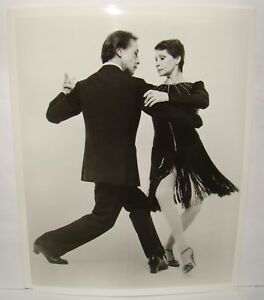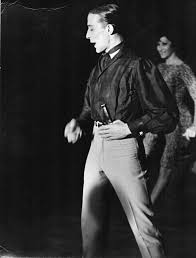I, Tango
Posted by Deirdre | Filed under Blog
Juan Carlos Copes, the Argentine dancer who brought tango to the world, has died from complications related to COVID-19. I want to pay tribute to this great dance artist and am reprinting an interview I did with him back when his hit stage show, Tango Argentino, was making audiences swoon around the world. The man danced with passion. His passion was the dance. Read on:

Juan Carlos Copes is the poet of the tango, an Argentine who rhapsodizes on the virtues of his country’s native dance with all the passion and conviction of a modern-day conquistador.
“When I was 16 and I danced the tango for the first time in the social clubs, I didn’t think I would be a professional,” said the 58-year old dancer and choreographer recently. “But I cried when I danced the tango, I felt something deep inside. . . . I’ve got my partner in my arms, the music is deep in my heart and I cried. I was ashamed of this, but then I discovered the tango is not man, it is not girl, the tango is real love. It is one heart and four legs. It is one feeling.”
Whew! It’s not even lunch time and Copes is talking a hot streak. The coffee drinkers at the next table are beginning to wilt. Copes is oblivious to what he is doing to these mild-mannered Canadians. Focused and intense, he is absorbed in the tango, or is it that the tango is absorbed in him?
For most of his life Copes has lived this sultry dance form, taking it out of the underground clubs where he and his friends went as thrill- seeking teen-agers, and into the sophisticated theatres of Buenos Aires, New York, Europe, the world.
He is perhaps best known today as the choreographer and star of Tango Argentino, the Broadway hit that in 1985 won him a Tony nomination and a tribute in the New York Times as dancer of the year.

He and Maria Nieves, his partner of almost 30 years (they were married once and are now divorced, but that’s a different story), were certain they would never tour again after Tango Argentino. They had been out of their country for almost two years when they called it quits in Munich in 1986. Copes, married now to a non-dancer, missed his wife and two young daughters. He moved back to Buenos Aires and was just settling into domesticity when Miguel Rimolo, a transplanted Argentine now living in Toronto, burst into his life with a new script.
“I said ‘no, no more,’ but he insisted and then I read the script and I found many important things. It was like somebody bringing my life to me. The dance, the music, the songs – it was my life, but also the story of my country. I think, nobody did before something like this, it is completely different from Tango Argentino, because it is not just a synthesis of my life, not just about my people; it is for everybody. It identifies with people from all over the world, when you will understand that it has something that belongs to you.”
In other words, Copes took the job.
He is now living in Toronto, where A Rose For Mr. Tango is scheduled to open tonight at the Music Hall Theatre. Copes did the choreography and co- stars with Nieves and Canada’s Victor A. Young. (Young also co-directs with Rimolo and wrote the script with him.)
Rimolo chose Toronto for the show’s world premiere because, besides being his home, it is “the second centre for live theatre in the world after Broadway.” If it does well here, Rimolo hopes to take the $1-million show on the road. Copes hears this and grimaces. “At my age, I’m very happy just staying in one place. I don’t know what will happen,” he shrugs. “Maybe this will be a success and I will stay in Toronto. I’d like that. It’s so quiet, so clean! Not many political problems, not like in Argentina, anyway.”
Argentina. This is where the tango originated more than 100 years ago, in the streets around the port of Buenos Aires. The dance sprang up in the bordellos and dingy nightclubs where soldiers, sailors and gauchos went to meet women. Its disreputable origins and frankly sexual character made it the target of ostracism from the high ranks of society.

“The tango’s choreography is a racial melting pot,” Copes explains. “The music was played by musicians who livened up the quilombos (whorehouses) of the time, mixing African rhythms, or Candombe, with the Habanera (a Cuban melody) and the Milonga (the song of the gauchos). Some special steps came in from the docks – mazurkas, polkas, waltzes – and the instruments used to play this music – the flute, the violin and the guitar – were mixed in as well.”
When the tango’s music made it to Paris around 1910, its sensual and exotic rhythms sparked a European dance craze. Suddenly the tango shed its machismo”whorehouse image to emerge as a cosmopolitan dance for the perfect couple.
“The tango is something between a woman and a man, 50-50,” Copes rhapsodizes again. “It is a feeling and you dance with that feeling. . . . It’s a dialogue but without words. It’s the closest thing to love in real life.”
Despite the international cachet, the tango was slow to gain acceptance in its home city. Copes recalls people telling him that tango dancing was for pimps, drug dealers or gamblers.
Copes wanted to legitimize the passions the dance aroused, and in 1955, after seeing a Gene Kelly musical at the local cinema, he decided to make a musical based on his country’s own rhythms and dances. He studied ballet, modern dance and acrobatics to furnish his ambition with the right materials, and in October of that year produced the first professional tango concert.
“It was revolutionary,” Copes recalls. “Never before had my country’s story been put on the stage through tango dance.” Copes, with Nieves, soon began spreading the word, performing in Venezuela, Cuba and El Salvador before appearing in North America in venues such as New York’s Waldorf Astoria and Toronto’s O’Keefe Centre in 1961.
“I feel like an ambassador because in many ways I represent my country,” Copes says. “I run all over the world with the tango – the Orient, Europe, Scandinavia, all over America. I do it because I love this dance. It was my passion, it is my passion. It is for me everything. I never changed for another dance and never will.”
